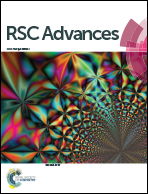Bi-layer hole-injecting layer composed of molybdenum oxide and polyelectrolyte for solution-processed OLEDs with prolonged stability†
Abstract
Currently, poly(3,4-ethylene-dioxythiophene):poly(styrene sulfonic acid) (PEDOT:PSS) is predominantly used as the hole-injecting layer in solution processed organic light-emitting diodes (OLEDs). However, its strong acidity is detrimental to device stability. Here, a bi-layer hole-injecting layer (BHIL) composed of molybdenum trioxide (MoO3) and an anionic polyelectrolyte has been used in solution processed OLEDs to replace PEDOT:PSS. The MoO3 layer was firstly solution deposited using low temperature combustion processing, which ensured that the device had a good hole-transporting ability. Then, an anionic polyelectrolyte was deposited on to the MoO3 layer also using a solution process, resulting in work function increase which was verified using peak force Kelvin probe force microscopy. Thus, the hole-injecting ability of the BHIL was found to be enhanced. It was found that BHIL-based OLEDs possessed a comparable electroluminescence performance but a better shelf-stability relative to the PEDOT:PSS based devices. This strategy gives a promising approach to obtaining high performance solution processed OLEDs with long-term stability.


 Please wait while we load your content...
Please wait while we load your content...